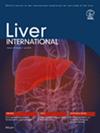Chronic hepatitis D virus (HDV) infection can cause severe liver disease. With new treatment options available, it is important to identify patients at risk for liver-related complications. We aimed to investigate kinetics and predictive values of novel virological and immunological markers in the natural course of chronic HDV infection.
HBcrAg, HBV RNA and quantitative anti-HBc were analysed in samples from HDV-infected patients at three consecutive time points. Results were linked to clinical outcome by univariable and multivariable analyses. Primary endpoint was the composite endpoint of any liver-related event.
Samples from 190 individual patients were analysed with a median clinical follow-up time of 2.69 (IQR 1.13–6.51) years. The majority of patients had cirrhosis (98/190, 52%), and the primary endpoint occurred in 33% (62/190). In univariable analysis, age, cirrhosis, lower quantitative anti-HBc, higher ratio of HBcrAg/anti-HBc and detectable HDV RNA were associated with the primary endpoint. In multivariable analysis, only the presence of liver cirrhosis (HR 7.74, p < 0.001) and age (1.06, p < 0.001) remained independently associated with the primary endpoint. Kinetics of virological parameters during follow-up were similar between the groups. Quantitative anti-HBc was significantly lower in patients with liver cirrhosis (687 (IQR 188–3388) IU/ml vs. 309 (IQR 82–924) IU/ml, p < 0.0004), and lower levels were independently associated with the development of the primary endpoint (HR 1.0, p = 0.014).
In chronic HDV infection, neither baseline values nor kinetics of HBV RNA, HBcrAg and anti-HBc were independently associated with clinical outcome, while stage of liver disease and age were predictors of liver-related events.



